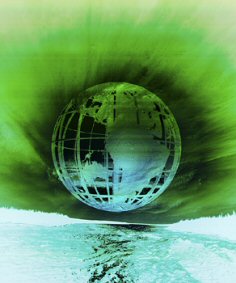5 November 2009
Midwest still shakin' all over - 200 years later
by Kate Melville
 New seismological research shows that the majority of modern earthquakes in the Midwest United States are merely aftershocks of a big quake that occurred two centuries ago. The study, conducted by researchers from Northwestern University and the University of Missouri-Columbia, appears in the latest issue of Nature.
New seismological research shows that the majority of modern earthquakes in the Midwest United States are merely aftershocks of a big quake that occurred two centuries ago. The study, conducted by researchers from Northwestern University and the University of Missouri-Columbia, appears in the latest issue of Nature.
"This sounds strange at first," said Northwestern's Seth Stein, who led the study. "On the San Andreas fault in California, aftershocks only continue for about 10 years. But in the middle of a continent, they go on much longer."
Stein explains that the difference is that the two sides of the San Andreas fault move past each other at a speed of about one and a half inches in a year - which is fast on a geologic scale. This motion "reloads" the fault by swamping the small changes caused by the last big earthquake, so aftershocks are suppressed after about 10 years. The New Madrid faults in the central US, however, move more than 100 times more slowly, so it takes hundreds of years to swamp the effects of a big earthquake.
"A number of us had suspected this," said co-researcher Mian Liu, "because many of the earthquakes we see today in the Midwest have patterns that look like aftershocks. They happen on the faults we think caused the big earthquakes in 1811 and 1812, and they've been getting smaller with time."
To test this idea, the researchers used results from lab experiments on how faults in rocks work to predict that aftershocks would extend much longer on slower moving faults. They then looked at data from faults around the world and found the expected pattern. For example, aftershocks continue today from the magnitude 7.2 Hebgen Lake earthquake that shook Montana, Idaho and Wyoming 50 years ago.
"This makes sense because the Hebgen Lake fault moves faster than the New Madrid faults but slower than the San Andreas," Stein noted. "The observations and theory came together the way we like but don't always get."
"Aftershocks go on for long times in other places inside continents," Stein added. "It even looks like we see small earthquakes today in the area along Canada's Saint Lawrence valley where a large earthquake occurred in 1663."
The new results will help investigators in both understanding earthquakes in continents and trying to assess earthquake hazards there. "Until now," Liu observed, "we've mostly tried to tell where large earthquakes will happen by looking at where small ones do. That's why many scientists were surprised by the disastrous May 2008 magnitude 7.9 earthquake in Sichuan, China - a place where there hadn't been many earthquakes in the past few hundred years."
Related:
Earthquakes Still Threaten The Central United States
Quake detection gets cheap and cheerful
Source: Northwestern University
